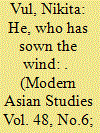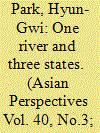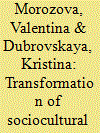|
|
|
Sort Order |
|
|
|
Items / Page
|
|
|
|
|
|
|
| Srl | Item |
| 1 |
ID:
162846


|
|
|
|
|
| Summary/Abstract |
One feature of Chinese Catholicism, as identi�ed by o�cial Chinese
investigation, is that most Chinese Catholics belong to traditional
Catholic families and communities, which include generations of
believers. �is is a relatively stable religious population, whose growth
depends largely on the continuity of the family and the community. To
explore the origins of this legacy, this article studies the formation and
early development of Chinese Catholic communities in Northeast
China and their models of religious governance. It argues that the widespread Catholic missions since the 19th century diffused not only
religion but also notions of autonomy and models of local governance
among Chinese Christians. Based on archival research and �eldwork,
the article focuses on two Catholic communities in Northeast China.
�ese two cases demonstrate that the early development of Northeast
Catholic communities was largely due to immigration and the absence
of the state. �e growth of the community coincided with the formation
|
|
|
|
|
|
|
|
|
|
|
|
|
|
|
|
| 2 |
ID:
133471


|
|
|
|
|
| Publication |
2014.
|
| Summary/Abstract |
The art photography of Fuchikami Hakuy? and his circle in Japanese Manchuria is commonly and benignly treated as hybridized modernism, a product of the bending of conventional 1930s Japanese styles (pictorialist, constructivist, realist) through contact with the unfamiliar and the exotic. As such it is deemed reflexive in relation to the stimuli of a new land and peoples, but disconnected from the political, economic, and social processes of imperialism and colonialism in Northeast China. The following article uses both structuralist and post-structuralist theoretical approaches to challenge this interpretation, arguing that through the skilful erasure of colonial violence and disruption, the lyrical images of villages, agriculturalists, and factories produced by Fuchikami and his Mansh? Shashin Sakka Ky?kai (Manchuria Photographic Artists Association) participate directly in processes of state construction in Manchukuo. The development of a quasi-documentary pastoral aesthetic by Fuchikami and the Manchuria photographers is given close attention in the analysis, particularly as it relates to the influence of French Barbizon school painting on late nineteenth- and early twentieth-century Japanese art.
|
|
|
|
|
|
|
|
|
|
|
|
|
|
|
|
| 3 |
ID:
141087


|
|
|
|
|
| Summary/Abstract |
This article deals with the Sino–Soviet conflict of 1925–26 over the Chinese Eastern Railway, with special attention given to its background and consequences. In 1924, the Chinese Eastern Railway became a joint venture between the Soviet Union and China, creating fresh friction between the joint Soviet and Chinese managers which culminated in general manager A.N. Ivanov's prohibition on transporting military cargoes and troops, and Ivanov's arrest by Manchurian warlord-general Zhang Zuolin. Some scholars and diplomatists have viewed Ivanov's prohibition and the simultaneous rebellion by Chinese general Guo Songling against Zhang as a Soviet attempt to replace Zhang with a more manageable warlord. But this article argues that although the prohibition—a typical instance of back-and-forth Soviet diplomacy—was a coincidence, it was primarily the result of Soviet ambassador Lev M. Karakhan's tough stance and his rash decision-making, undertaken without seeking advice from Moscow. Zhang's victory in the 1926 clash convinced the Chinese that they had the power to take repressive measures against the Soviet Union's citizens and institutions, which led to the Sino–Soviet conflict of 1929 and exacerbated Japanese alarm over the Soviet's increasing strength in the region. This was to be a factor in the takeover of Manchuria in 1931 by Japan's Guandong Army, which eventually led to global war. This article, therefore, deals with the origins of world-changing events and thus is interesting to Modern Asian Studies’ wider readership.
|
|
|
|
|
|
|
|
|
|
|
|
|
|
|
|
| 4 |
ID:
147336


|
|
|
|
|
| Summary/Abstract |
In this article, I address the contradictions and paradoxes inherent in the development of the Tumen River triangle area. After briefly examining the history and background of the international development project, I explore how it has been implemented and the problems it has faced in the Russian Far East and North Korea, in contrast with its relatively successful development in China. My argument is that the core concept in Tumen River development became closely interlinked with the local variants of postsocialist transition. The difficulties created by Russia and North Korea derive from the dismantling of their state economies, which paradoxically has led to a preoccupation with sovereignty rather than the pursuit of a market economy.
|
|
|
|
|
|
|
|
|
|
|
|
|
|
|
|
| 5 |
ID:
190600


|
|
|
|
|
| Summary/Abstract |
Straw energy utilization has been considered a prosocial practice, which is conducive to increasing the efficiency of agricultural waste resources and improving the ecological environment. Individuals' willingness to engage in such a prosocial technology relies on the double constraints of rational and altruistic factors. This paper develops a theoretical model to understand the function of rationality and altruism in rural households' acceptance of straw energy utilization. Partial least squares structural equation modeling is employed to test and evaluate the research data collected by a cross-sectional survey in Northeast China. Results display that 82.7% of the variance is explained by the proposed model in rural households' acceptance of straw energy utilization. Personal norms, attitude, perceived behavioral control, and subjective norm have significantly positive effects on the willingness to adopt straw energy utilization, and the effects sequentially weaken (i.e., 0.422, 0.245, 0.167, 0.166, respectively). The influence coefficients of rational predictors are 0.578, while the influence coefficients of altruistic predictors are 0.422. Overall, rational predictors exert more significant effects on rural households' acceptance of straw energy utilization than altruistic predictors. In addition, promotion strategies and policies for straw energy utilization are provided based on the motivation analysis in rural households' acceptance.
|
|
|
|
|
|
|
|
|
|
|
|
|
|
|
|
| 6 |
ID:
101200


|
|
|
|
|
| Publication |
2010.
|
| Summary/Abstract |
The growth and transformation of state-owned enterprises (SOEs) in a changing socialist China has long been a popular focus of scholarly attention.Relatively little has been done to explain the growth dynamics and regional variation of China's SOEs. This paper investigates the spatial variation of China's SOEs through a comparative analysis of SOEs in northeast and southChina. A detailed comparison of SOEs in the machinery industry sector located in Shenyang in the northeast and Guangzhou in the south has revealed an interesting pattern inwhich SOEs in the two locations were positioned in different production environments characterized by different norms of market competition and different types of political ties with the central state. The non-price norm of market competition and a political commitment to a state strategy of key equipment indigenization have provided incentives for SOEs in Shenyang to adopt a technically-oriented and independent-brand-based growth strategy in their direct engagements with transnational corporations, and these engagements have caused them to pursue the rapid expansion of production capacity and sales income at the expense of capital efficiency and external economies. In contrast, the pressures ofmarket competition plus hardened budget constraints enforced by local governments has forced SOEs in Guangzhou to fall back on externally malleable production linkages and inter-firm networks, which have enabled them to adapt to emerging markets during the economic transition. While SOEs in the two locations share the same public property rights arrangements and operate in the same industrial sector, they are actually "different dreams" within the "same bed."
|
|
|
|
|
|
|
|
|
|
|
|
|
|
|
|
| 7 |
ID:
164063


|
|
|
|
|
| Summary/Abstract |
This article analyzes the process of transformation in the frontier sociocultural spaces of Russia and China on the example of the regional pair Trans-Baikal Territory of Russia - Northeast China (Dongbei). The authors describe their functioning in three dimensions - local, national, and foreign cultural. In this context, it seems relevant to address the special practice of developing frontier areas, which today are not only an outpost, but also a place of active interaction of countries, cultures, and civilizations.
|
|
|
|
|
|
|
|
|
|
|
|
|
|
|
|
| 8 |
ID:
092201


|
|
|
|
|
| Publication |
2009.
|
| Summary/Abstract |
The success of coastal China in mobilizing resources from the overseas Chinese community has been well documented, and is deemed to have played an important role in the expansion of the Chinese economy. This article adopts a new approach by looking at the issue from the point of view of an ethnic minority border region. It explores the mobilization of the Korean minority's transnational ties in the service of local economic development in the Yanbian Korean Autonomous Prefecture, located in Jilin Province at the North Korean border. These pursuits are conceptualized as "transnationalism from above," whereby the local government focused on mobilizing, institutionalizing, steering and controlling transnational activities in support of its own specific goals. How were these linkages built up and how did the government balance between the positive and negative, or the "sweet and sour" aspects of transnational ethnic capital transfers? The study points to a new mechanism for economic development that is emerging along China's borders.
|
|
|
|
|
|
|
|
|
|
|
|
|
|
|
|
|
|
|
|
|